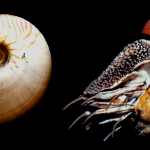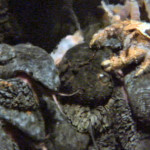I know I was supposed to be live blogging the conference, but there is just so much to do and see here the ASLO Ocean Sciences conference! Running from 9am to 7:30pm with 16 concurrent sessions and over 4000 participants this meeting was huge. So I am going to pick a few highlights from the meeting.
Charlyene Bachraty presented work on modeling biogeographic dispersal at hydrothermal vents. Based on a multivariate regression tree of species distributions, she determined 6 vent biogeographic provinces. Though some of her work suffers from sampling effort bias (as is true in most of the deep sea), her ideas about biogeography are interesting and deserve further testing. For instance, in her model the East Pacific Rise is the center of dispersal. It is also the most heavily sampled hydrothermal vent site. Furthermore, there are also many shared species between the Northwestern Pacific and Southwestern Pacific biogeographic provinces, so I am unsure why they are separate provinces when previous authors combined them as one.
There was also an entire session devoted to Long-Term Ecological Research in the Deep Sea. There were many interesting talks, but here are a couple of my favorites. Michael Vardaro presented some crazy sea urchin footage (can we get copy??) where they are racing around and bioturbating, leaving crazy trails everywhere. Jeff Drazen also presented some fantastic new results on the diet of macrourid fish (rattails). Apparently carrion is the largest component of their diet.

One of the more fun sessions was on the Impacts and Interactions of Soft-Bottom Benthic Systems. Sally Woodin presented some of her research on how worms and crustaceans, which burrow into soft sediment, give off pressure pulses. Bob Feller gave an entertaining talk on ellipses. Specifically, why we should take into account the true area of a core sample when measuring the diversity of small anemones contained in that core. He showed that there is a consistent difference in field samples when sampling on a slope either by pushing the core straight down or perpendicular with the slope (so that it approximates a true cylinder). The result was striking. Almost twice as much diversity when standardizing using a formula for a cylinder, not taking into account the extra sediment when the core is angled in relation to the substrate. So, corers beware!
Several researchers presented their results from recent expeditions to methane seep communities in the deeper parts of the Gulf of Mexico at a session with the long, all-encompassing title: Interactions Among the Chemistry, Geology and Biology of Hydrocarbon Seep Communities in the Deep Gulf of Mexico. Many fascinating talks here. My favorites were talks by Erik Cordes characterizing the bathymetric trends and biogeography of seep communities below 1000m and Stephane Hourdez describing the phylogenetic relationships among the chemoautotrophic tubeworms. There are several new species of tubeworm and there even appears to be a species from Chile in the deep Gulf!
All in all a great meeting, the largest I’ve ever been to. I met many fantastic scientists, presented a poster of new species of vent anemones and drank copious amounts of alcohol with had intriguing scientific conversation with leading researchers.






‘Running from 9am…’- what are you talking about? The intriguing conversations must have kept going on for a bit as the rest of us started at 8am…
Ole, your right! It was 8am LOL
> Michael Vardaro presented some crazy sea urchin footage
> (can we get copy??) where they are racing around and
> bioturbating, leaving crazy trails
Oh, yes, please — have you asked him /suggested posting?
> …there is a consistent difference in field samples when
> sampling on a slope either by pushing the core straight
> down or perpendicular with the slope (so that it
> approximates a true cylinder). The result was striking.
Naive question here — how much does this matter for other
core work generally? Other organisms? Other materials, or relative proportions thereof? Ice cores? Rock cores?
Was he talking about new soft mud or geologically old cores?
And is this saying there’s a difference in the way things accumulate on a slope, or is this about slopes produced by some geological change after forming layers on flat bottom?
Hank,
Feller made it a point to say that it didn’t matter what you were coring. The fact of the matter is if you standardize to the volume of a cylinder without taking into account the angle you pushed the core into, your counts will be off and hence any interpretation!
He did a study comparing cores taken on a slope. One set he cored straight down (thus the top of the core was elliptical inside of circular) and the other he cored perpendicular so it most closely approximated a cylinder (circular). He applied the cylinder formula for both sets when standardizing species counts and found that the elliptical core consistently had nearly twice as much diversity as the cylindrical core.
Part of the biological reason is that there are more species closer to the surface. The elliptical core samples more of the surface layer. In other fields, ice coring, rock coring, etc. may suffer from similar interpretations.